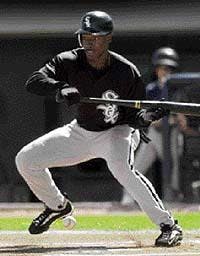If you've ever played baseball, pickup games or organized games, you probably had a favorite bat. In my youth I played first base in high school, then industrial league, fast-pitch softball when stationed in New York City with the U.S. Army and later in a Greater-Boston suburban league. I clearly recall searching for THE bat among the assortment of models that each team provided because you weren't allowed to mark your name after finding that perfect bat. And hitting slumps were always blamed on not having that special bat.
Dave Cook knows about this. He's a former scout for the New York Yankees who, in 1986, invented and patented a composite, three-piece (ash, hickory, maple) bat, which he claims is stronger, has a better sweet spot and is lighter. In 1991 Dave founded Hoosier Bat Company (www.hoosierbat.com) in Valparaiso, Indiana, about 50 miles west of Chicago, to market this bat.
It turns out that composite bats are a bit of a sell. Dave's wife Debbie says that he is not a shrinking violet and with his minor and major league contacts he managed to attract some interest. However, the pros and collegiate athletic directors prefer his solid ash bats. Ash is the wood of choice because it offers strength and lightness, while providing the heft that is required to drive a ball long distances. So Hoosier Bat, with a reputation for a better bat, went into competition with the major bat manufacturers, in rented space in Valparaiso.
Dave's contacts brought in orders and, as various amateur, scholastic and professional leagues gave approval, the composite bat sales took off. Why a composite bat you may ask? I did and Debbie told me it's still a wood handle so you have to hold it correctly, with the label facing up. This is said to be the strong side of the bat. If you've ever played the game you recall having it drilled into your head, label up. With an ash bat, over time and after many hits, the barrel begins to peel and flake away, and that's why, as a kid you often had to use a taped bat. With hickory you don't get this effect, so in the Hoosier bat the hitting area is hickory, and the company guarantees that this won't happen. Cook's bat is ash in the handle area, hickory in the hitting region and maple on the barrel end to keep the bat weight down, because hickory is a heavy wood, and to give the bat balance.
Major leaguers are using the composite bat in batting practice all the time, but it is going to be a matter of going through the right steps to get the necessary approvals before it is used in a major league game. Major league rules state that a bat must be all solid wood and not more than 42 inches long and 2 3/4 inches in diameter at the thickest part. Major league baseball says the bat can only be one of four colors, natural, black, burnt orange and hickory. Debbie says this would not be a problem with the composite, which can be stained any color.
Hoosier buys its wood in billets that are 36-38 inches long and 2 3/4 inches round. It cuts the billet to a uniform length, then separates them by major or minor league stock and then turns them to order. At Hoosier's facility seven employees are required to produce a day's orders. One person runs two lathes, two people sand, one person does the color finish, one person screen prints logos and one person laser engraves customer names and one ships the finished product.
Back when it got started the company found a rule that says you have to put the major league player's name on the bat. (It does this as a courtesy to minor league players, because the larger bat suppliers won't.) The company started by branding or screen-printing the player's name, which was difficult to do although this was the way all bat manufacturers did it. An article about Hoosier in a local paper prompted a local job shop to contact it about the possibility of laser engraving. Samples were laser marked and Hoosier was pleased with the crisp engraving and the pleasantly charred finish. So it began sending all bats requiring personalization to this shop. Logos and other marks continue to be silk-screened. The company's logo is still screen printed today.
After a bit Hoosier decided to explore purchase of its own laser marker, because of a need for faster order turnaround time and the cost involved in shipping bats some 50 miles away. Turnaround time can make the difference between receiving an order or not. In one example an equipment manager called on a Tuesday and told the company he needed bats for a major league on Friday. Hoosier filled the order in time and established a reputation for on-time delivery. This is especially important because Hoosier does not start turning a bat to specification until it has an order.
Player's names are computerized and laser engraved as block printing. The company tried engraving a player's signature once but all his bats disappeared quickly, so it was asked not to do this again. Engraved names are about 1/8-in. deep and wide and, because of major league rules, must fit within 1/2-inch X 2-inch area.
Hoosier's decision to purchase a laser marker was also predicated by its perception that local business in engraved trophies and plaques was a possibility. For example, Hoosier now engraves a large number of bats that are used as wedding gifts, engraved with the bride and groom's names. Full-sized promotional bats are also engraved for corporations and other organizations.
The laser, purchased about eight years ago, was the same as the one the job shop used, a Laser Machining Inc. (LMI; Somerset, WI) model 225C, equipped with a 25-watt CO2 laser. Debbie trained for one day at LMI and received excellent after-installation support as she learned to program the marker.
Hoosier uses CorelDraw software, types in the person's name, and mounts the bat in a simple holding fixture under the laser's beam delivery head. Fumes from the process are exhausted out of the plant. For major league players only one line of printing is used, but for some other orders it has done more than one line. For one team the entire roster was engraved and for another the names were done in script.
Bats for major league players take about 30 seconds. The company engraves eight hours/day, five days/week, and turns out 200 bats/day.
Hoosier features the laser engraving as a selling tool, although it is offered at no charge. Debbie says laser engraving has brought the company customers from all over the world. From October until February Dave and Debbie travel to exhibitions to show their products. They do not have players under contract for endorsement but they get business because of their service.
What separates Hoosier bats from those supplied by the big companies and about 48 other smaller competitors? Players say the wood is harder than bats produced by the other companies. And Hoosier makes sure customers get their order on time and get what they ordered.
Hoosier's business is growing every year. And one of these days we may see that composite bat used widely in the major leagues.

David Belforte | Contributing Editor
David Belforte (1932-2023) was an internationally recognized authority on industrial laser materials processing and had been actively involved in this technology for more than 50 years. His consulting business, Belforte Associates, served clients interested in advanced manufacturing applications. David held degrees in Chemistry and Production Technology from Northeastern University (Boston, MA). As a researcher, he conducted basic studies in material synthesis for high-temperature applications and held increasingly important positions with companies involved with high-technology materials processing. He co-founded a company that introduced several firsts in advanced welding technology and equipment. David's career in lasers started with the commercialization of the first industrial solid-state laser and a compact CO2 laser for sheet-metal cutting. For several years, he led the development of very high power CO2 lasers for welding and surface treating applications. In addition to consulting, David was the Founder and Editor-in-Chief of Industrial Laser Solutions magazine (1986-2022) and contributed to other laser publications, including Laser Focus World. He retired from Laser Focus World in late June 2022.
